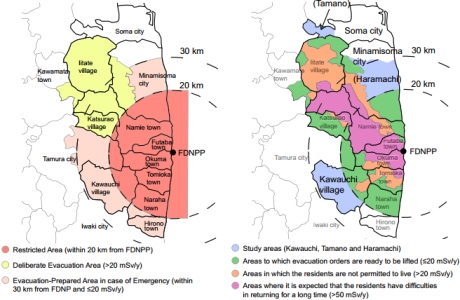A newly published study of the radiation doses received by Fukushima residents has concluded that most people in the prefecture are unlikely to receive doses significantly different to normal background radiation levels as a result of the accident.
The study, by Japanese researchers led by Akio Koizumi of the Kyoto University Graduate School of Medicine, has been published in the Proceedings of the National Academy of Sciences of the United States of America (PNAS). It evaluates radiation dose rates from deposited radiocesium in three areas within 20-50 km of the Fukushima Daiichi plant. It took into account external doses, measured by dosimeters worn by 458 participants, as well as estimating doses from inhalation and dietary intake. Measurements were recorded in August-September 2012, just over a year on from the accident of March 2011. All three of the study areas - Tamano, Haramachi and Kawauchi village - neighbour regions which are still evacuated or have only limited access.
 |
Most of the Fukushima-related radiation received by the study subjects was found to be from external sources - deposited radiocaesium, referred to as "groundshine" - rather than diet or inhalation. The study found that in 2012, the mean annual radiation dose rate associated with the Fukushima event was 0.89-2.51 mSv per year – close to Japan's average annual background radiation exposure of 2 mSv/yr.
The researchers employed the linear no-threshold (LNT) dose-response model, which assumes that health risk is directly proportional to radiation exposure and that even the smallest radiation exposure carries some risk. From their observations, the researchers concluded that in 2022, mean doses will be comparable with variations in the background dose across Japan. "The extra lifetime integrated doses after 2012 is estimated to elevate lifetime cancer risk by a factor of 1.03-1.05 at most," the researchers say. At these levels, increases in cancer rates are not likely to be epidemiologically detectable. "The simple and conservative estimates are comparable with variations in the background dose, and unlikely to exceed the ordinary permissible dose rate (1 mSv/y) for the majority of the Fukushima population," the authors note.
The authors acknowledge that the short-term nature of the study does lead to some uncertainties - for example, previous studies in the region have found that snowfall can offer a shielding effect, effectively lowering doses from terrestrial radiation in the winter months. Neither does the current study evaluate the dose received during the first year after the accident. Nevertheless, they say, the work provides "perspective on the long-term radiation exposure levels" in the three regions.
The research paper, 'Radiation dose rates now and in the future for the residents neighboring restricted areas of the Fukushima Daiichi Nuclear Power Plant', is available through PNAS's open access website.
In January 2013, the World Health Organization (WHO) said that there is only a low risk to Japan's population due to radioactivity released by the Fukushima accident. For the general population in wider Fukushima prefecture, across Japan and beyond "the predicted risks are low and no observable increases in cancer rates above baseline rates are anticipated," WHO said. However, it raised estimations of cancer risk for two towns near the Fukushima Daiichi plant - Namie and Iitate - where an unknown number of people may have remained at home for four months after the accident.
Researched and written
by World Nuclear News




_47120.jpg)

_23621.jpg)






